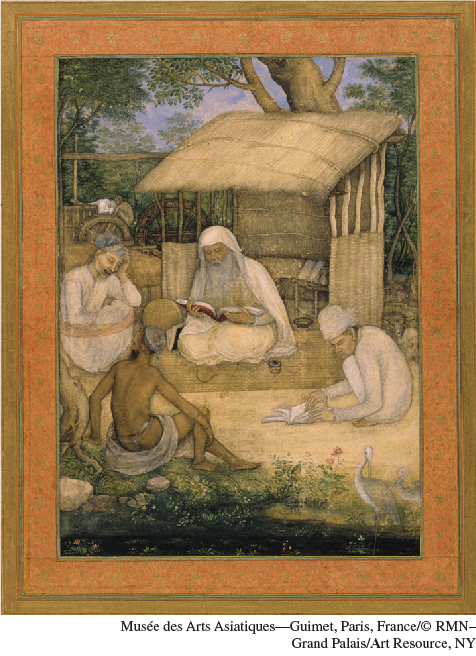South Asian Religion: From Ritual Sacrifice to Philosophical Speculation
AP® EXAM TIP
You should know examples of writings from major belief systems in world history, such as the Vedas and the Upanishads (see page 158).
Despite the fragmentation and variety of Indian cultural and religious patterns, an evolving set of widely recognized sacred texts provided some commonality. The earliest of these texts, known as the Vedas (VAY-
Guided Reading Question
▪CHANGE
In what ways did the religious traditions of South Asia change over the centuries?
From this dissatisfaction arose another body of sacred texts, the Upanishads (oo-PAHN-ee-shahds). Composed by largely anonymous thinkers between 800 and 400 B.C.E., these were mystical and highly philosophical works that sought to probe the inner meaning of the sacrifices prescribed in the Vedas. In the Upanishads, external ritual gave way to introspective thinking, which expressed in many and varied formulations the central concepts of philosophical Hinduism that have persisted into modern times. Chief among them was the idea of Brahman, the World Soul, the final and ultimate reality. Beyond the multiplicity of material objects and individual persons and beyond even the various gods themselves lay this primal unitary energy or divine reality infusing all things, similar in some ways to the Chinese notion of the dao. This alone was real; the immense diversity of existence that human beings perceived with their senses was but an illusion.
The fundamental assertion of philosophical Hinduism was that the individual human soul, or atman, was in fact a part of Brahman. Beyond the quest for pleasure, wealth, power, and social position, all of which were perfectly normal and quite legitimate, lay the effort to achieve the final goal of humankind — union with Brahman, an end to our illusory perception of a separate existence. This was moksha (MOHK-shuh), or liberation, compared sometimes to a bubble in a glass of water breaking through the surface and becoming one with the surrounding atmosphere.
AP® EXAM TIP
Know the basic teachings of the major Eurasian belief systems, like reincarnation in Hinduism.
Achieving this exalted state was held to involve many lifetimes, and the notion of samsara, or rebirth/reincarnation, became a central feature of Hindu thinking. Human souls migrated from body to body over many lifetimes, depending on one’s actions. This was the law of karma. Pure actions, appropriate to one’s station in life, resulted in rebirth in a higher social position or caste. Thus the caste system of distinct and ranked groups, each with its own duties, became a register of spiritual progress. Birth in a higher caste was evidence of “good karma,” based on actions in a previous life, and offered a better chance to achieve moksha, which brought with it an end to the painful cycle of rebirth.
AP® EXAM TIP
Take good notes on the social and political effects of India’s caste system, both here and in Chapter 5.
If Hinduism underpinned caste, it also legitimated and expressed India’s gender system. As South Asian civilization crystallized during the second-

And yet some aspects of Hinduism served to empower women. Sexual pleasure was considered a legitimate goal for both men and women, and its many and varied techniques were detailed in the Kamasutra. Many Hindu deities were female, some life-giving and faithful, others, like Kali, fiercely destructive. Women were particularly prominent in the growing devotional cults dedicated to particular deities, where neither gender nor caste was an obstacle to spiritual fulfillment.
A further feature of Hindu religious thought lay in its provision of different paths to the ultimate goal of liberation, or moksha. Various ways to this final release, appropriate to people of different temperaments, were spelled out in Hindu teachings. Some might achieve moksha through knowledge or study; others by means of detached action in the world, doing one’s work without regard to consequences; still others through passionate devotion to some deity or through extended meditation practice. Such ideas — carried by Brahmin priests and wandering ascetics or holy men, who had withdrawn from ordinary life to pursue their spiritual development — became widely known throughout India.